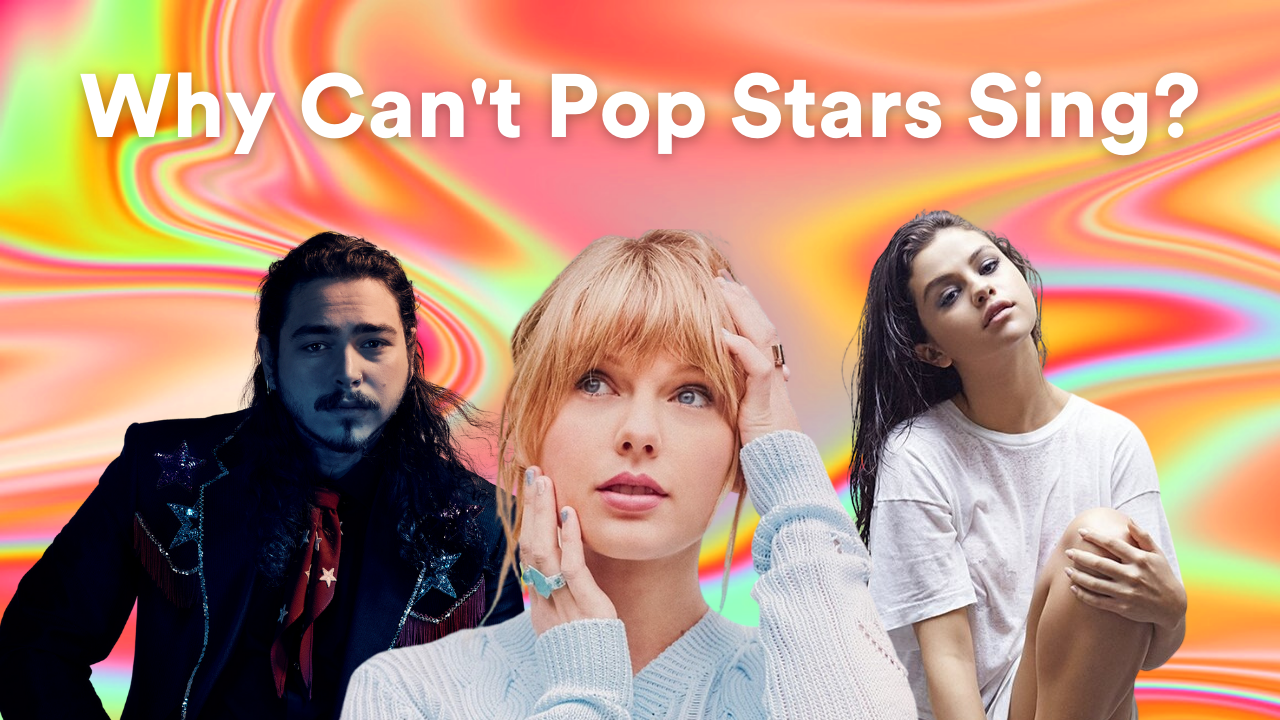The age-old industry question has a few possible answers.
While it’s hard to say with complete certainty, it does seem that the average vocal talent of top industry talent has been decreasing over the last several years and decades. Artists such as Taylor Swift, Post Malone, and Selena Gomez, have come under fire for subpar live performances – or for just not being able to sing at all. Recording artists in the 20th century had to rely on only their bodies to give pitch-perfect performances. Why is that not the case today?
Reason #1: Sex Appeal Is Paramount
Yes, vocal ability matters, but in the digital age, visuals can be just as important as sound in the experience of modern music. In Pop music even more so than other genres, sex appeal plays a critical role in the success of an artist. From music videos, to live performances, brand partnerships, and marketing materials, the artist’s face and body are often the first things that the public perceives, even before the music. For musicians who reach the apex of the industry, they reach that height because of some degree of sex appeal. Even if they don’t have a lot of it, there truly is someone for everybody. One can surmise that an artist like Rihanna was made viable primarily because of her sex appeal, with the vocal talent being refined after the fact.[1]This performance doesn’t demonstrate above-average vocal talent, yet took place roughly around the time she was discovered. Of course, Rihanna has improved dramatically since this performance.
In the west, sex appeal is typically associated with lean and skinny body types, which isn’t necessarily conducive to having strong core muscles and diaphragm. The way breath support works is by using the diaphragm to hold back air, not push it forward. For people with more weight on their chest and stormach, their diaphragm, core, and back muscles have to work harder to do that and are stronger than people who have less weight on their torso.[2]Read more about how the voice works through the Complete Vocal Institute. Therefore, skinnier people often have weaker breath support and weaker voices.
Reason #2: Defunding of the Arts
Since the late 20th century, arts and music education in schools has been slashed in favor of other programs, resulting in weaker instruction and curricula. Before then, students in public schools were often receiving coaching from professionals in these fields for hours a week, allowing them to reach – or get close to – the 10,000-hour mark it takes to master a skill.[3]From the classic piece of literature: Outliers. With weaker training at the crucial adolescent age, there simply aren’t as many vocalists of the same caliber as there were in years past, because of the new financial barrier to good education.
Reason #3: The Democratization of Music Technology
It’s an open secret now that the rapid acceleration of music technology has allowed vocalists of varying levels of talent to sound at least tolerable. It’s not just the nebulous “auto-tune,” but also software like Melodyne, a personal favorite of Billie Eilish producer Finneas, as he put it:
This technology allows producers to transpose recordings seamlessly into different keys, and as well as alter the tonal qualities of one’s voice in post-production. Now more than ever singers can sound like trained vocalists in the studio, which creates expectations that they may fail to meet in live settings.
Not only this but with music production technology like Garageband widely available to so much of the public, the bar for entry into the music industry is also lower than ever before, allowing merely average vocalists to find an audience and create entirely new (bedroom) genres (which may not be a bad thing!).
Reason #4: The Public Wants a Piece
A fourth potential cause that is worth considering is that the public may want to hear singers that are more in line with their own personal abilities. Singing along to a Mariah Carey track may sound like fun until you pop a blood vessel in your neck. While there are still pop stars today that are far more capable vocalists than the average American (looking at you, Ariana Grande), we may be seeing some fatigue from extraordinary vocalists, resulting in more average, replicable, but attractive ones rising to the top. Most would likely agree that singing along to a song is more fun than just listening to it, and that’s accomplished better with a song that has a melody on the staff rather than above it.
This could also explain why pop music tends to prefer lighter and brighter vocal types, like light sopranos and tenors over more dramatic and darker voices as they are more common.
While these reasons may help to explain why singers today might not be up to par with those of the past, this shouldn’t be seen as an excuse to delegitimize anyone’s art or performance. Many pop stars today have different strengths than those of the past, such as songwriting or dancing, which isn’t necessarily a bad thing. Most people aren’t born with or get to harness great vocal talent, and those with it shouldn’t be the only ones allowed to sing pop music. If it is easier for them to sound like professionals with less work so that they can focus on other aspects of their art, who cares? Just enjoy the performance like the rest of the public.
References
| ↑1 | This performance doesn’t demonstrate above-average vocal talent, yet took place roughly around the time she was discovered. Of course, Rihanna has improved dramatically since this performance. |
|---|---|
| ↑2 | Read more about how the voice works through the Complete Vocal Institute. |
| ↑3 | From the classic piece of literature: Outliers. |




